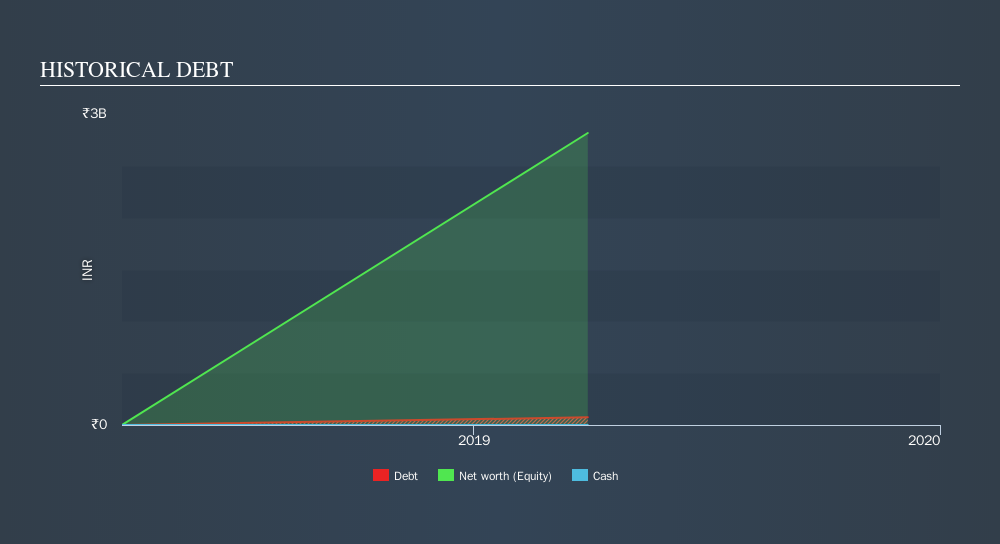
David Iben put it well when he said, 'Volatility is not a risk we care about. What we care about is avoiding the permanent loss of capital. It's only natural to consider a company's balance sheet when you examine how risky it is, since debt is often involved when a business collapses. We can see that The Anup Engineering Limited (NSE:ANUP) does use debt in its business. But is this debt a concern to shareholders?
Why Does Debt Bring Risk?
Debt assists a business until the business has trouble paying it off, either with new capital or with free cash flow. In the worst case scenario, a company can go bankrupt if it cannot pay its creditors. While that is not too common, we often do see indebted companies permanently diluting shareholders because lenders force them to raise capital at a distressed price. Of course, plenty of companies use debt to fund growth, without any negative consequences. The first step when considering a company's debt levels is to consider its cash and debt together.
View our latest analysis for Anup Engineering
How Much Debt Does Anup Engineering Carry?
The image below, which you can click on for greater detail, shows that at March 2019 Anup Engineering had debt of ₹73.8m, up from in one year. Net debt is about the same, since the it doesn't have much cash.

How Healthy Is Anup Engineering's Balance Sheet?
Zooming in on the latest balance sheet data, we can see that Anup Engineering had liabilities of ₹1.02b due within 12 months and liabilities of ₹133.6m due beyond that. Offsetting these obligations, it had cash of ₹66.0k as well as receivables valued at ₹728.6m due within 12 months. So it has liabilities totalling ₹426.4m more than its cash and near-term receivables, combined.
Of course, Anup Engineering has a market capitalization of ₹4.25b, so these liabilities are probably manageable. Having said that, it's clear that we should continue to monitor its balance sheet, lest it change for the worse.
We measure a company's debt load relative to its earnings power by looking at its net debt divided by its earnings before interest, tax, depreciation, and amortization (EBITDA) and by calculating how easily its earnings before interest and tax (EBIT) cover its interest expense (interest cover). This way, we consider both the absolute quantum of the debt, as well as the interest rates paid on it.
Anup Engineering has a low debt to EBITDA ratio of only 0.12. And remarkably, despite having net debt, it actually received more in interest over the last twelve months than it had to pay. So there's no doubt this company can take on debt while staying cool as a cucumber. Although Anup Engineering made a loss at the EBIT level, last year, it was also good to see that it generated ₹561m in EBIT over the last twelve months. When analysing debt levels, the balance sheet is the obvious place to start. But it is Anup Engineering's earnings that will influence how the balance sheet holds up in the future. So if you're keen to discover more about its earnings, it might be worth checking out this graph of its long term earnings trend.
Finally, while the tax-man may adore accounting profits, lenders only accept cold hard cash. So it's worth checking how much of the earnings before interest and tax (EBIT) is backed by free cash flow. In the last year, Anup Engineering created free cash flow amounting to 16% of its EBIT, an uninspiring performance. For us, cash conversion that low sparks a little paranoia about is ability to extinguish debt.
Our View
Anup Engineering's interest cover was a real positive on this analysis, as was its net debt to EBITDA. On the other hand, its conversion of EBIT to free cash flow makes us a little less comfortable about its debt. When we consider all the elements mentioned above, it seems to us that Anup Engineering is managing its debt quite well. But a word of caution: we think debt levels are high enough to justify ongoing monitoring. Above most other metrics, we think its important to track how fast earnings per share is growing, if at all. If you've also come to that realization, you're in luck, because today you can view this interactive graph of Anup Engineering's earnings per share history for free.
If, after all that, you're more interested in a fast growing company with a rock-solid balance sheet, then check out our list of net cash growth stocks without delay.
We aim to bring you long-term focused research analysis driven by fundamental data. Note that our analysis may not factor in the latest price-sensitive company announcements or qualitative material.
If you spot an error that warrants correction, please contact the editor at editorial-team@simplywallst.com. This article by Simply Wall St is general in nature. It does not constitute a recommendation to buy or sell any stock, and does not take account of your objectives, or your financial situation. Simply Wall St has no position in the stocks mentioned. Thank you for reading.
About NSEI:ANUP
Anup Engineering
Manufactures and fabricates process equipment for oil and gas, petrochemicals, LNG, fertilizers, chemicals, pharmaceuticals, power, water, paper and pulp, and aerospace industries in India.
Outstanding track record with high growth potential.
Similar Companies
Market Insights
Community Narratives




